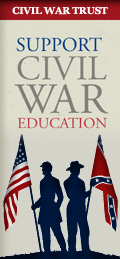|
Faces of the Civil War: An Album of Union Soldiers and Their Stories
By Harold Holzer
The Metroplitan Museum of Art for North & South Magazine
July 2005
Like many Civil War relic hunters, Ronald S. Coddington has for years collected photographs of soldiers in uniform — not the famous scenes taken on the battlefield to document death and carnage, but the simple little cartes de visite portraits that the men themselves commissioned to distribute to their loved ones before departing for the front. They have long been a familiar sight at flea markets and antique shops: discarded by the soldiers' descendants, staring back at modern observers with an almost quaint anonymity, looking not unlike stylized pictures of today's eager reenactors, only thinner.
Coddington had the ingenious idea of reconstructing the stories of those who usefully autographed their photos and, even better, listed their regiments. Armed with these valuable clues, Coddington searched military records and pension files to learn who they were and what they became when it ended — if they survived.
The result is a highly readable series of mini-biographies that puts a human face on the Union soldier. This is no attempt to define the Civil War fighting man. As Coddington acknowledges, these men are all white, mostly officers, principally Easterners, and all volunteers who eagerly rushed to serve their country. There are no reluctant conscripts here. Of course the chronicle also skews toward the wounded and sick — since their subsequent pension requests provided the best resource for information.
That said, the variety of background and experience is fascinating. Here are artists, farmers, shopkeepers, preachers, schoolmasters, lawyers, and laborers. They leave their sweethearts behind (often returning to marry them), send money to their parents, and do their duty commendably, even heroically. Some die in major battles, others in tiny skirmishes. They suffer hideous wounds, succumb to diarrhea or typhoid, wind up in dank prisons, and invariably show symptoms for the rest of their lives: skin rashes, hearing loss, blindness, and worse. One veteran, shot through the lung at Gettysburg, is observed in the street years later clinging "to the side of his meat wagon" gasping for breath. Another becomes such an abusine alcoholic that his daughter petitions the government to "stop my father's pension for he don't use any of it for the family. It all goes to drink." Other veterans lose their will to work or live — one slits his own throat — while a few simply vanish, tragically leaving their wives in pension limbo.
These are haunting stories — and so are their pictures. Whether made by the Brady studios or long-forgotten itinerants, they show eager, proud, occasionally frightened-looking men who brandish pistols in their belts, cradle swords, or fold their arms defiantly. A few pose before elaborate, if unconvincing, backfrops showing tents and American flags. Most stare directly into the camera, many for the first time, others for the last. And for all the wax moustaches and thick beards, readers may be haunted most by baby-faced Lieutenant Russell Babcock, all of nineteen years, clutching a bayonet that rises past his waist, a child going off to the war that ended America's innocence, and likely Babcock's, too. It's hard to imagine him the old man he became, but he lived to be eighty-three, and lives again thanks to Coddington's unique effort. Historian Michael Fellman provides an elegant foreword on the art and commerce of photography, which would have been even more useful with footnotes.
|
|
